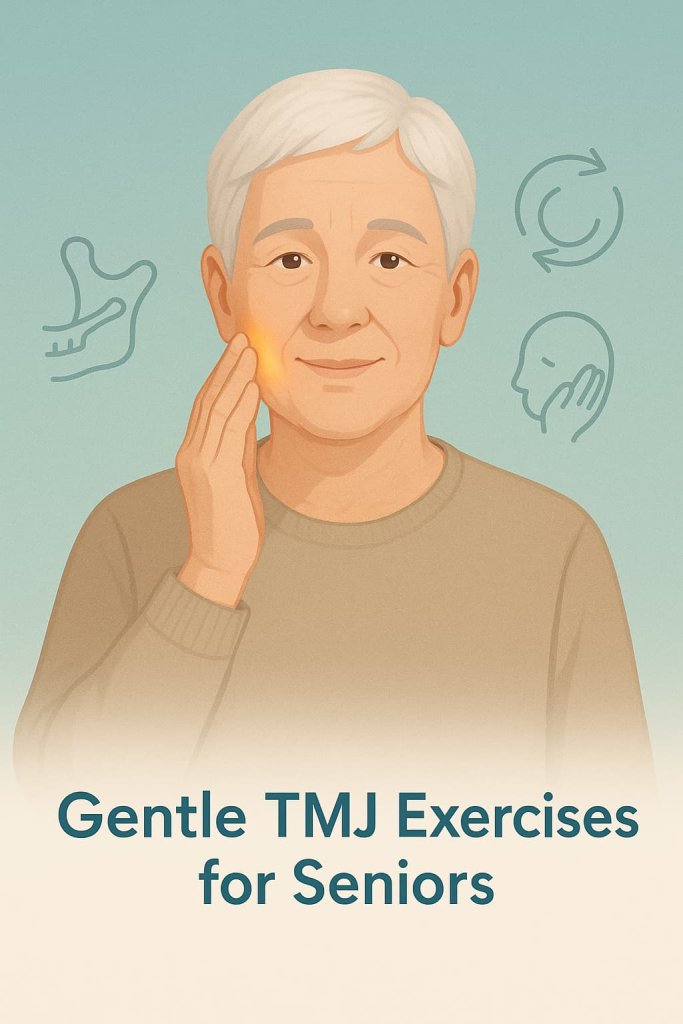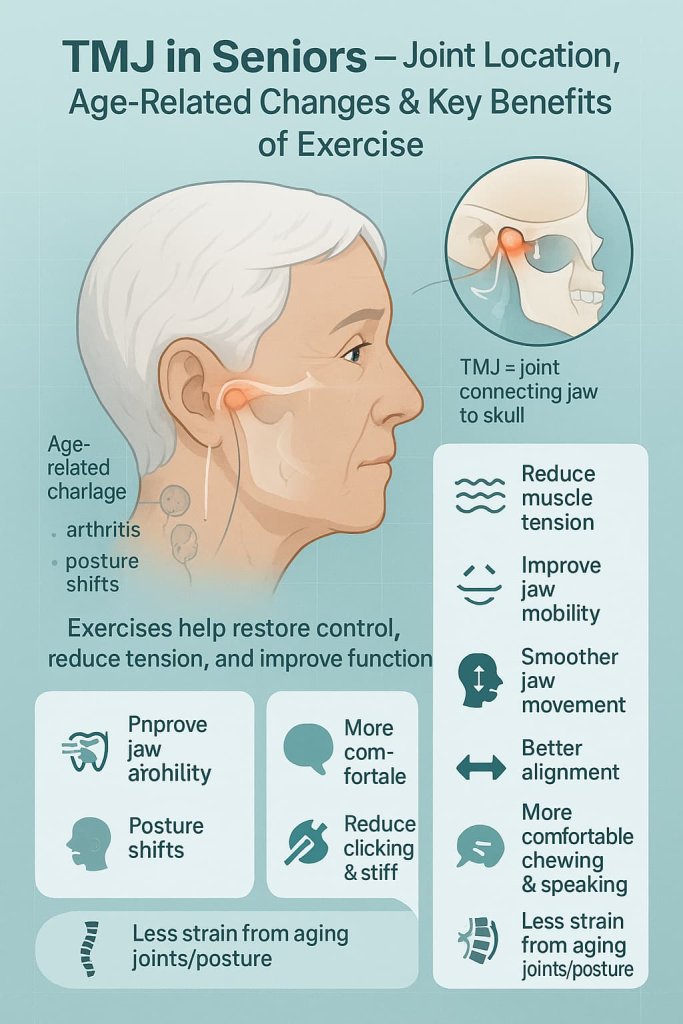Yes—gentle TMJ exercises can help seniors reduce jaw pain safely at home. These movements support smoother jaw mechanics, reduce muscle tension, and help restore comfortable chewing and speaking. Understanding how aging affects the jaw joint makes it easier to choose the right exercises and avoid unnecessary strain.

For older adults, TMJ discomfort often stems from age-related joint changes, arthritis, dental changes, posture issues, or long-term muscle tension. The right routine can help improve comfort, mobility, and daily function. Below, you’ll find the safest, most senior-friendly TMJ exercises—each explained with clear steps and modifications.
What Is the TMJ & Why It Matters for Seniors
The temporomandibular joint connects your jawbone to your skull and enables speaking, chewing, yawning, and swallowing. With age, this joint can become irritated due to cartilage wear, arthritis, weakened muscles, posture changes, or bite alterations from dental work or dentures.

For seniors, TMJ pain can affect eating, sleep, facial comfort, and even headaches. Exercises that improve control, reduce tension, and restore natural jaw alignment are considered a safe first-line option in conservative care.
Benefits of TMJ Exercises for Seniors
- Reduce jaw muscle tension and tightness
- Improve jaw mobility and overall movement control
- Support smoother opening and closing of the jaw
- Restore more natural jaw alignment
- Make chewing and speaking more comfortable
- Reduce clicking, stiffness, and mild popping
- Decrease strain caused by aging joints, posture issues, or dental changes.
Safety Tips Before Seniors Begin TMJ Exercises

Before exercising, seniors should follow these guidelines:
- Keep movements gentle and pain-free
- Sit upright with good back support
- Avoid wide mouth openings
- Perform motions slowly and smoothly
- Stop immediately if sharp pain, locking, dizziness, or new symptoms appear
- During flare-ups, combine exercises with rest, soft foods, and heat
- If you have recent trauma, severe arthritis, frequent locking, or unexplained ear symptoms, consult a clinician first
Consistency matters. Small sessions 2–3 times daily often work best.
Warm-Up Before You Begin
A brief warm-up prepares the jaw and neck for safe movement. Spend 1–2 minutes doing:

- Shoulder rolls (5–8 each way)
- Gentle chin nods (3–5 times)
- Small left–right neck turns (3–4 each side)
- Slow breaths with the tongue resting on the palate
This helps loosen stiffness and improves exercise comfort.
8 Best TMJ Exercises for Seniors
These eight gentle TMJ exercises are designed specifically for seniors to improve jaw comfort, mobility, and daily function. Each movement is easy to follow, joint-friendly, and safe to perform at home with minimal effort.
1. Resting Jaw Position & Tongue Posture
Why it works:
This foundational position helps relax the jaw by reducing unnecessary muscle activity. It decreases clenching pressure on the TMJ, encourages proper joint spacing, and helps retrain the jaw to rest in a neutral, stress-free position. Seniors often hold hidden tension in the jaw and neck, and this exercise helps break that pattern.
Muscles worked:
Masseter and temporalis (relaxation), suprahyoid and infrahyoid stabilizers, tongue posture muscles.
How to do it:
- Sit upright with your back supported and shoulders relaxed.
- Gently place the tip of your tongue on the roof of your mouth, just behind your upper front teeth.
- Allow your teeth to stay slightly apart (avoid touching or clenching).
- Keep lips relaxed and closed naturally.
- Breathe slowly through your nose for 30 seconds.
Trainer Tip:
Use this as your default jaw posture throughout the day—especially after eating, during TV time, or whenever you catch yourself clenching.
2. Controlled Partial Opening (“Mini Goldfish”)
Why it works:
Trains smooth, coordinated jaw opening without excessive translation of the joint. It helps reduce uneven motion, popping, and early clicking, which are common in seniors with mild TMJ stiffness or disc issues.
Muscles worked:
Early-phase jaw openers (suprahyoids), lateral pterygoid stabilizers.
How to do it:
- Sit upright with your tongue gently resting on the palate.
- Lightly place one finger on your chin to guide the motion.
- Slowly open your mouth just a small amount—like a “mini” opening—straight down.
- Pause briefly, then close with the same control.
- Repeat 5–8 times.
Trainer Tip:
Perform in front of a mirror to ensure your jaw does not drift sideways.
3. Controlled Full Opening (Tongue on Roof)
Why it works:
Encourages proper rotation-then-translation of the jaw joint, helping restore normal opening mechanics without overloading delicate tissues. Ideal for seniors who struggle with limited opening or morning stiffness.
Muscles worked:
Mandibular depressors, early-phase and mid-phase TMJ translators, suprahyoids.
How to do it:
- Keep your tongue on the roof of the mouth during the movement.
- Open your mouth slightly wider than the partial version, but stop before any discomfort or sharp clicking.
- Hold the open position for 2–3 seconds.
- Close slowly and smoothly.
- Repeat 4–6 times.
Trainer Tip:
If clicking becomes louder or painful, decrease the range until the movement feels smooth again.
4. Side-to-Side Jaw Movements
Why it works:
Improves lateral jaw control, reduces stiffness, and helps correct deviation during chewing. Seniors may develop uneven movement patterns due to dental changes or arthritis—this restores balanced motion.
Muscles worked:
Medial and lateral pterygoids, temporalis (posterior fibers), TMJ stabilizing structures.
How to do it:
- Let your teeth remain slightly apart and your jaw relaxed.
- Slowly move your lower jaw 3–5 mm to the right.
- Hold for 2 seconds, then return to center.
- Repeat to the left.
- Perform 5 gentle reps per side.
Trainer Tip:
Move in small, controlled increments. Seniors with dentures should reduce the range to avoid shifting or instability.
5. Jaw Forward Glide (Protrusion)
Why it works:
Strengthens and trains the forward sliding (translation) movement of the lower jaw, reducing excessive hinge action that contributes to clicking, popping, or pressure in the joint. It also promotes smoother chewing mechanics.
Muscles worked:
Lateral pterygoids, TMJ capsule and anterior stabilizers.
How to do it:
- Begin with your mouth slightly open.
- Slide your lower jaw forward so your bottom teeth move slightly ahead of your top teeth—or as far as feels comfortable.
- Hold for 1–2 seconds, then return to your natural position.
- Repeat 5 times.
Trainer Tip:
Gently place a finger on your chin to keep the motion straight forward, not downward or sideways.
6. Isometric Jaw Opening & Closing
Why it works:
Strengthens jaw musculature without large movements, making it ideal for seniors with arthritis, joint sensitivity, or limited range. Isometrics help stabilize the joint and reduce fatigue during chewing.
Muscles worked:
Masseter, temporalis, suprahyoids, jaw stabilizers.
Opening resistance:
- Place two fingers under your chin.
- Try to open your mouth slowly while your fingers gently resist the movement.
- Hold for 3 seconds, then relax.
Closing resistance:
- Place your hand on your chin.
- Gently press upward while attempting to close your mouth slightly.
- Hold for 3 seconds, then relax.
Repeat 4–5 times each direction.
Trainer Tip:
Resistance should be minimal. If it feels like strength training, you’re pushing too hard.
7. Chin Tucks (Neck Posture Exercise)
Why it works:
Improves head and neck alignment, which directly affects TMJ load. Seniors often develop forward head posture, increasing jaw strain. Chin tucks help decompress the joint and support natural jaw mechanics.
Muscles worked:
Deep cervical flexors, upper-back stabilizers, suboccipital muscles (stretch).
How to do it:
- Sit tall with your back supported and shoulders relaxed.
- Draw your chin straight back, creating a gentle “double chin.”
- Avoid tilting your head down—movement is horizontal.
- Hold 3–5 seconds, then relax.
- Repeat 5–6 times.
Trainer Tip:
Imagine your head sliding back along a wall—this helps keep your spine aligned.
8. Gentle Jaw Stretch (Comfortable Range Only)
Why it works:
Provides a mild stretch to improve mobility and reduce stiffness, especially in seniors who struggle with limited opening. Works best when the joint is stable (no locking or sharp clicks).
Muscles worked:
Jaw openers (suprahyoids), TMJ capsule, soft tissue around the mandible.
How to do it:
- Sit upright and rest your tongue gently on the palate.
- Open your mouth slightly wider than normal, but stay within a pain-free range.
- Hold the stretch for 2–3 seconds.
- Close slowly.
- Repeat 3–4 times.
Trainer Tip:
If clicking worsens or becomes painful, avoid stretching and return to controlled-opening drills until stability improves.
How Often Should Seniors Do TMJ Exercises?
For best results:
- 2–3 short sessions per day
- Perform exercises slowly and gently
- Continue daily for 3–6 weeks
- Reduce intensity during flare-ups
- Pair with posture work and relaxation breathing
Most seniors notice improvement in comfort and motion with consistent practice.
Who Should Avoid These Exercises? (Important)
Seniors should NOT perform TMJ exercises without professional guidance if they have:
- Recent jaw trauma or fracture
- Frequent jaw locking (open or closed)
- Severe arthritis causing joint instability
- Sudden inability to chew or open the mouth
- Unexplained dizziness, nerve symptoms, or facial numbness
- Sudden change in bite or facial swelling
Always consult a dentist or physical therapist if symptoms worsen or don’t improve.
Common Mistakes Seniors Should Avoid
To prevent irritation, seniors should avoid:
- Opening the mouth too wide
- Using excessive force or fast movements
- Practicing with poor posture
- Skipping warm-up
- Continuing through painful clicking, locking, or sharp discomfort
Staying gentle and controlled ensures the exercises remain safe and effective.
FAQs
1. Are these TMJ exercises safe for seniors with arthritis?
Yes—when kept gentle and pain-free. Seniors with moderate to severe TMJ arthritis should start with the smallest movements.
2. Can seniors with dentures do these exercises?
Yes. Keep movements small and controlled; stop if dentures shift uncomfortably.
3. How long until TMJ exercises start working?
Most people feel improvement within 3–6 weeks of consistent practice.
4. What should seniors avoid during TMJ flare-ups?
Hard, chewy foods, gum, wide mouth opening, long phone calls (jaw tension), and leaning forward for long periods.
5. Is clicking dangerous?
Painless clicking is common. Painful clicking, new clicking, or clicking with locking needs professional evaluation.
6. Can I do these exercises lying down?
Seated with back support is better for alignment, especially for seniors.
7. Are TMJ exercises a replacement for professional treatment?
No. They are a conservative self-care tool, not a substitute for medical assessment.
Conclusion
TMJ pain can significantly affect seniors’ daily comfort, but gentle, structured exercises can make a meaningful difference. By practising these eight movements consistently—along with posture awareness and joint-friendly habits—you can support better jaw control, easier chewing, and less pain.
Start today with the first two exercises, then gradually add the rest over the next week. Consistency is the key.
This content is for informational purposes only and not medical advice.
References
- Effectiveness of exercise therapy on pain relief and jaw mobility in patients with pain-related temporomandibular disorders: A systematic review (Shimada et al., 2023)
- Exercise therapy improves pain and mouth opening in temporomandibular disorders: A systematic review with meta-analysis (Idáñez-Robles et al., 2023)
- Effectiveness of an 8-week neck exercise training on pain, jaw function, and oral health-related quality of life in women with chronic temporomandibular disorders: A randomized controlled trial (Oliveira-Souza et al., 2024)
- Effects of Physiotherapy on Pain and Mouth Opening in Temporomandibular Disorders: A Systematic Review and Meta-Analysis (Arribas-Pascual et al., 2023)
- Effectiveness of non-invasive physiotherapy techniques in temporomandibular disorders: A systematic review (Sood et al., 2025)
- Physiotherapy management of temporomandibular joint (TMJ) pain – Patient leaflet (Royal Berkshire NHS, 2023)
- TMJ Exercises – Advice and self-management for jaw pain (Oxford University Hospitals NHS)
- Physiotherapy management of temporomandibular joint (TMJ) pain – Patient information leaflet (Worcestershire Acute Hospitals NHS, 2025
